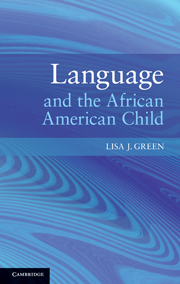Book contents
- Frontmatter
- Contents
- Figures
- Tables
- Foreword
- Preface
- Note on the text
- 1 Child AAE: an introductory overview of the data and context
- 2 Characterizing AAE: feature lists, dual components, and patterns and systems
- 3 System of tense–aspect marking 1: non-past and habitual
- 4 System of tense–aspect marking 2: past time
- 5 Negation: focus on negative concord
- 6 Asking questions: seeking clarification and requesting elaboration
- 7 Variation: intra-dialectal/variable-shifting and inter-dialectal/code-shifting
- 8 The D.I.R.E.C.T. Model: linking linguistic description and education
- Appendix A: List of participants
- Appendix B
- Notes
- References
- Index
2 - Characterizing AAE: feature lists, dual components, and patterns and systems
Published online by Cambridge University Press: 05 June 2012
- Frontmatter
- Contents
- Figures
- Tables
- Foreword
- Preface
- Note on the text
- 1 Child AAE: an introductory overview of the data and context
- 2 Characterizing AAE: feature lists, dual components, and patterns and systems
- 3 System of tense–aspect marking 1: non-past and habitual
- 4 System of tense–aspect marking 2: past time
- 5 Negation: focus on negative concord
- 6 Asking questions: seeking clarification and requesting elaboration
- 7 Variation: intra-dialectal/variable-shifting and inter-dialectal/code-shifting
- 8 The D.I.R.E.C.T. Model: linking linguistic description and education
- Appendix A: List of participants
- Appendix B
- Notes
- References
- Index
Summary
LJG: <directed to the duck puppet about Zeke’s excellent performance on the elicitation and comprehension tasks>
Watch Z__. He knows how to get these answers. So watch how quiet he is and watch how he pays attention.
Zeke: We finna – we fin – I finna pass this test.
Introduction
What is AAE? The answers to this question or the definition can vary depending on perspective. For instance, the focus can be placed on the speakers, such that AAE can be characterized as a way of talking by groups of African Americans. Also, AAE has been even more narrowly defined as the “vernacular” form used by African American youth and young adults who are part of the popular culture. Such characterizations do not provide much insight into the AAE linguistic system itself, nor do they say much about the patterns used as part of the linguistic system, although they do link AAE to groups of African Americans and to social use of language. In the description in this book the focus will be on the AAE linguistic system and ways to capture developmental patterns. Three methods of characterizing AAE that are concerned with properties of the linguistic system itself are used in the literature and each captures certain intuitions about the linguistic variety. Also, each method places emphasis on a different property of the linguistic variety. For reference, I will use the following labels for the models of methods of characterizing AAE: feature lists, dual components, and patterns and systems. The method of portraying AAE that is more in line with the approach in this book is the patterns and systems characterization.
2.1 Feature lists and density measures: how AAE differs from MAE
The tradition of characterizing adult AAE in such a way to show how it differs maximally from MAE remains strong. The approach is to list a line of features that are in opposition to what is acceptable in standard American English, and it goes back to early studies in AAE when, in the beginning stages, researchers were trying to explain what actually constitutes AAE. One common list is in Wolfram and Fasold (1974), in which AAE is addressed along with other American English social dialects. Of course, the earlier feature lists are based on observations of adolescent and adult language, but the lists have also been extended to child AAE. For instance, in categorizing AAE according to what they have observed in the speech of children in the pre-kindergarten through fifth grade age groups, Craig and Washington (2006) give a list of morphosyntactic features, some of which are also commonly associated with adolescent and adult AAE. Craig and Washington’s introduction links the features in the list to standard American English: “The morpho-syntactic feature system includes the variations from SAE [Standard American English] that involve free and bound morphemes, and word order” (p. 35). Thus AAE is characterized in terms of the way it differs from MAE; the “features” in the list are not associated with MAE. The 24 features Craig and Washington isolate are reproduced here:
Features Suggested in the Literature
- Type
- Chapter
- Information
- Language and the African American Child , pp. 21 - 35Publisher: Cambridge University PressPrint publication year: 2010



